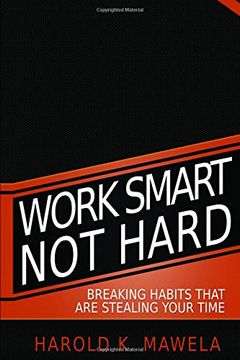Reseña del libro "Work Smart not Hard: Breaking Habits That are Stealing Your Time (en Inglés)"
People have always searched for better and more efficient ways of doing things, whether it involved a more effective way of trapping animals for food or a more efficient way of starting a fire with friction. But it wasn’t until the later 1800s and early 1900s that anyone took a purposeful, scientific approach to getting things done faster with less effort. Frederick Winslow Taylor is normally considered to be the father of scientific management. He wrote his book, The Principles of Scientific Management in 1911, which, together with the work of Frank and Lillian Gilbreth, became the launching pad for today’s time management. It started as a quest to increase productivity in manufacturing, focused on the efficiency of individual workers, quickly spread to the office, and eventually encompassed the home environment as well. Taylor sought a one best way to do every job, standardizing work methods and tools in order to increase productivity. Taylorism, as it was called, began to change the way organizations functioned. Before this time, organizations were usually set up in homes or informal businesses where the workspaces were open. There were no barriers to communication and ideas could flow freely among employees. Instead, manufacturing areas and offices were separated, work became specialized, procedures became fixed and efficiency increased. Unfortunately communications decreased. Temporarily at least, human relations took a back seat to productivity. This was not Taylor’s intention. He was trying to make it easier for the employees as well as have them increase productivity. Although he didn’t coin the “work smarter, not harder” phrase, this was his intention.Frank and Lillian Gilbreth also had an impact by introducing time and motion study to the manufacturing process. The Gilbreths had twelve children and the movie Cheaper by the Dozen was based on their lives. They demonstrated that the same principles being applied in business could be adapted to the home. Their work gave rise to industrial engineering, time studies, and incentive standards, and a continuous pursuit of efficiency, not only in the plants but in offices as well.What this quest for efficiency did in most cases was alienate the workers. Human relationships took a back seat. People were in separate areas or offices, took timed coffee breaks and lunch hours at specific times, and in many cases punched a clock every time they came and went – to keep track of hours worked. Workers were disciplined for chatting too long at the water cooler or kidding around in the factory. Policies, procedures and rules were developed. They usually stifled employee interaction, discouraged creativity and generated greater union activity. So the backlash, if I can call it that, was the human relations movement, where it was felt that a happy worker was a productive worker. We went from isolated offices to cubicles without doors, landscaped offices with movable partitions or no partitions, office Supervision changed from an authoritative or dictator style to a consultative or participative style. But that era, and the organizational development era that followed were motivated by the same desire to maximize employee productivity.parties and Christmas bonuses. A lot of time clocks were eliminated. Communication meetings were introduced and so on. It’s ironic that the current digital era that we’re in now is once again dehumanizing the work environment, decreasing personal interaction, reducing our creativity, and in some ways putting us back into the scientific management era. But this time we are doing it willingly rather than having it imposed on us. And it’s mainly because we’re being seduced by technology.

